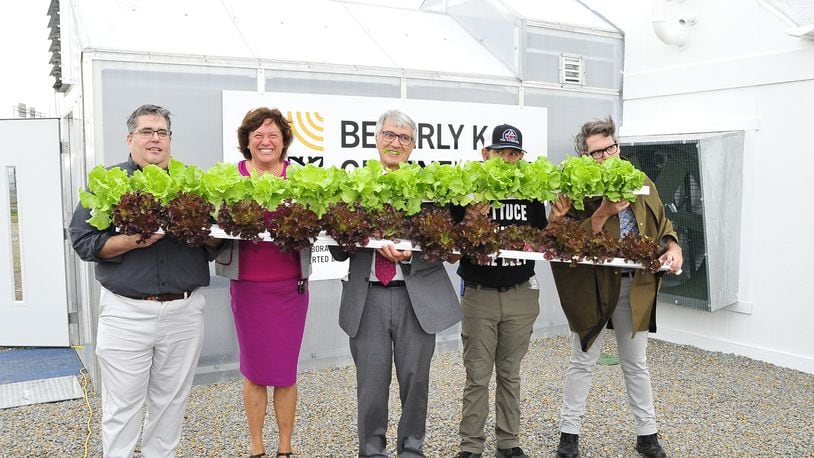Shortly after the 2019 Memorial Day tornadoes devastated parts of the Dayton area, Beverly’s son Charlie Greene and her husband Tom Greene met with Foodbank CEO Michelle Riley, Chief Development Officer Lee Lauren Truesdale and garden manager James Hoffer to discuss making an enduring gift to the community in Beverly’s memory. Charlie had developed an interest in gardening, and he knew a hydroponic greenhouse — which uses up to 90% less water than traditional gardening—could help provide fresh vegetables year-round for people facing food insecurity in the Dayton area.
“We decided to name the greenhouse after my mother when it became a reality that she wasn’t going to beat her cancer and was transferred to hospice care,” Charlie Greene said.
Additional contributions for the greenhouse flowed in from many of Beverly’s friends and family members, and several companies stepped in to offer in-kind donations: Ernst Concrete; Danis Construction; Chapel Electric Co.; Heapy Engineering; AC Elliott Design; L.L. Klink; and MSD.
But Charlie, not satisfied with simply making the greenhouse a reality, decided he would also help secure its future. In the spring of 2022, he plans to open a nursery called Tadmor Greenes to sell native plants and offset operation costs for the Beverly K. Greenehouse.
Charlie’s idea for a native plant nursery has both personal and practical sides. After living on the East and West coasts for 20 years, he returned to Dayton to act as caregiver for his mother when she became ill. During that time, he sought solace in gardening, began volunteering at the Marianist Environmental Education Center in Beavercreek and became “obsessed” with native plants. He learned that adding native plants to a property can restore native ecosystems, increase biodiversity and nurture native wildlife.
Charlie said his mother, not much of a gardener herself, began to share his enthusiasm for native plants. Learning about new native species provided a welcome distraction for them both during her illness.
“My mother may have been the worst gardener and called native plants ‘weeds,’ ” Charlie said, “but it was her strength and determination to make things right for our community and her constant craving to learn more. We learned together the whole time going through chemo treatments. She loved that I found my passion in native plants and was really proud.”
When Charlie saw that eco-friendly landscapes were burgeoning in popularity, he realized growing and selling native plants could bring in funds for the greenhouse.
Truesdale also emphasized the significance of the Greene family’s contribution. “It’s rare that a donor reaches out to a nonprofit and it turns out to be this large of a project,” she said. “Keeping someone’s memory alive through what Charlie’s doing is so impactful. We’re just really honored to be a part of that.”
GreeneCharlie got the name “Tadmor” from a village that once existed near the Greenes’ property in Vandalia, before it was destroyed in the 1913 flood. It is also a play on the phrase “a tad more.” He said the nursery will initially offer several popular native plants such as purple coneflower, dense blazing star, Virginia mountain mint and wild ginger and later expand to additional species. So far, Charlie is growing all the plants himself.
Customers of the nursery will be given the opportunity to exercise generosity themselves with a “buy one, give one” program: the option to purchase a second plant for a Foodbank client who lacks resources.
Both the greenhouse and nursery, he said, are his family’s positive responses not only to their loss but also to the Dayton tornadoes, the Oregon District mass shooting in 2019, the pandemic and other challenges Dayton has recently faced.
“The greenhouse will be a beacon of determination that will lead to closing the gap of inequality in our community,” Greene said. “This is how we are going to move forward.”
“I miss [my mother] every day and still talk to her every day,” Greene said, “and seeing her name on the greenhouse makes me overwhelmed with pride.”
Kari Carter is a member of The Journalism Lab of Dayton and an instructor at Sinclair Community College.
About the Author
